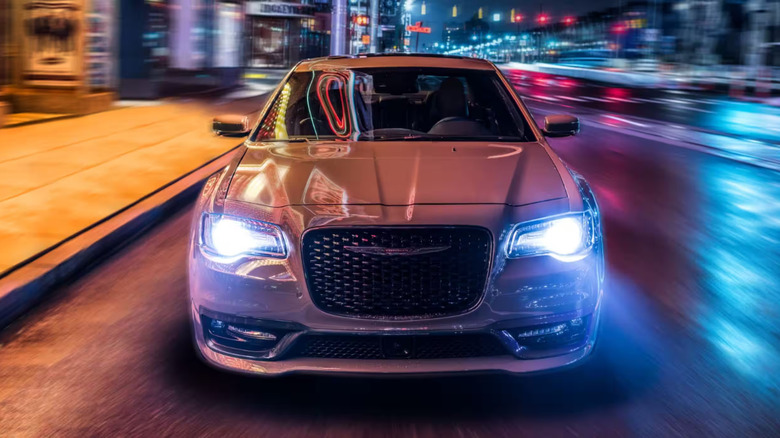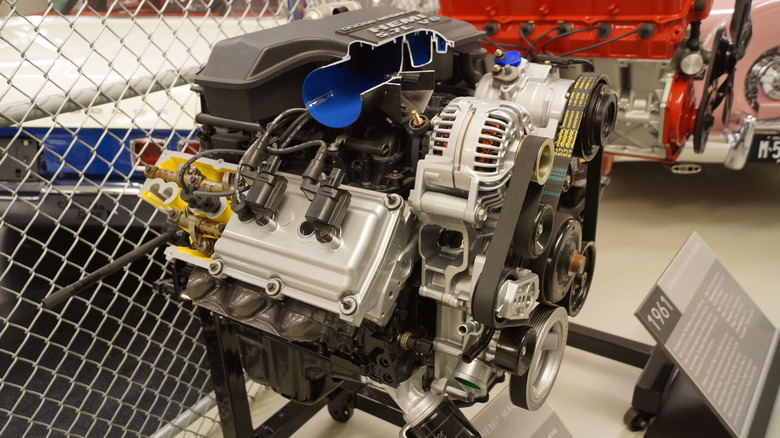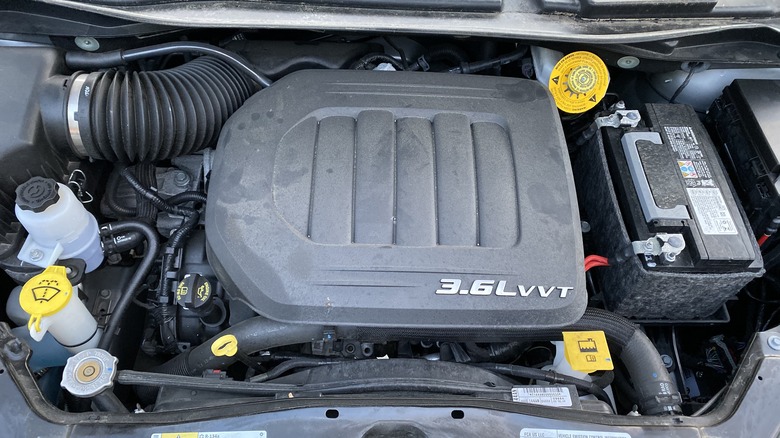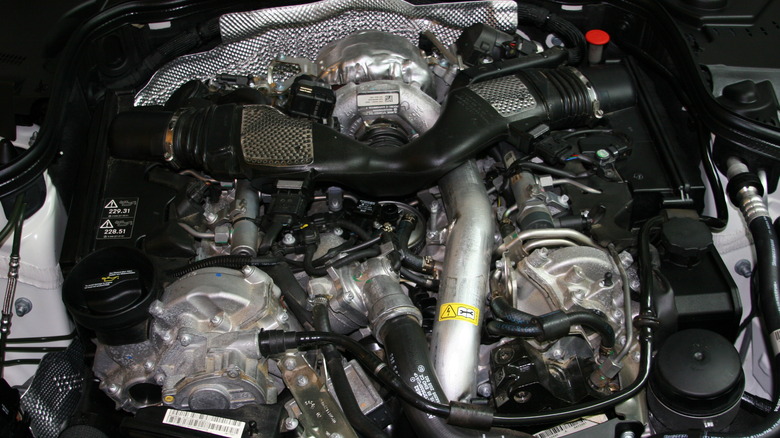Which Engines Were Used In The Chrysler 300 Through The Years?
The Chrysler automotive brand has been around for about 100 years now, and over the past century, the American automaker has created vehicles that tons of drivers have enjoyed; from the New Yorker, to the Imperial, to the Town and Country minivan. Today, the company has shrunk down to the point where it only produces one model in total — the Chrysler Pacifica. However, this is a rather new development, because 2023 saw the end of production of one of the company's most iconic vehicles of the last 30 years. This would be the Chrysler 300 sedan, the modern evolution of the company's 300 "letter series" that began in the mid-1950s.
When it was first introduced in 2005, the image of the Chrysler 300 was inescapable. This was a vehicle that looked to be as luxurious as any car on the road, but you were able to get it at a reasonable price. You look at hip-hop music videos from the mid-to-late 2000s, or episodes of "MTV Cribs" from the time, and you will see the Chrysler 300 all over the place, even alongside cars that cost tens of thousands more.
While the aesthetics of the Chrysler 300 were its cultural defining factor, there still had to be something worthwhile underneath the hoods of these sedans. Over its near 20-year existence, Chrysler had a fairly wide variety of engines available for it. Let's break down all the V6s, V8s, as well as diesel options, available for the two Chrysler 300 generations.
First-generation V6s
Back in 2005, the standard issue engine you were going to get in a Chrysler 300 was the company's 2.7L V6 engine. This featured a dual overhead camshaft and a bore and stroke of 3.39 by 3.09 inches. Putting this not very large engine in the somewhat large body of the 300 meant that this wasn't going to measure off the charts when it came to power, maxing out at about 190 horsepower and 190 pound-feet of torque.
Those aren't terrible numbers at all, but considering that the Chrysler 300 would go on to win Best Car of 2005 from MotorTrend and be among the top ten of that year from Car and Driver, it was a pretty perfect engine. The 2.7L V6 remained standard for the 300 through the 2010 model, marking the end of the vehicle's first generation. The Chrysler 300 had a variety of different packages that altered performance, luxury, or both, and one of those was the Touring model.
Not only did the 300 Touring come with perks like Sirius Satellite Radio capabilities, but it came with a larger, more powerful engine: a 3.5L V6. This V6 engine actually predates the 2.7L V6 by a few years, and served as the inspiration to create that smaller engine. The major structural change is that the 3.5L V6 features a single overhead camshaft, rather than the dual design of the newer engine. The bore and stroke of the 3.5L was 3.78 by 3.19 inches, making it able to generate up to 250 horsepower and 250 pound-feet of torque. This was also your standard engine in the Limited package and the base model of the 300 if you were purchasing it in Canada.
[Image by S. Foskett via Wikimedia Commons | Cropped and scaled | CC BY-SA 3.0]
First-generation V8s
The upper tier models of the Chrysler 300 did not stop at the Limited, and neither did the available engines. Another variation of the sedan was the Chrysler 300C, and that did not come equipped with a standard V6 engine. Instead, you would find a 5.7L HEMI V8 underneath the hood, featuring a hemispherical combustion chamber. While this does dramatically increase power, it does mean less mileage.
This particular 5.7L Hemi V8 in a Chrysler 300C would be able to generate up to 340 horsepower and 390 pound-feet of torque, a massive jump up from the previous 3.5L V6. When the next generation of the 300 rolled around in 2011, Chrysler was able to bump that up to 363 horsepower and 394 pound-feet of torque. This 5.7L Hemi V8 would be the only engine that would survive both generations of the Chrysler 300 until its discontinuation.
Then there's the last and highest-performance model of the first generation: The Chrysler 300C SRT-8. Instead of the 5.7L Hemi V8, this was given the even larger 6.1L Hemi V8. Along with the bore and stoke increasing to 4.055 by 3.579 inches, a good deal was altered for this Hemi engine, including using different elements for improved cooling and durability. The 6.1L Hemi V8 allowed the big-bodied sedan to max out at 425 horsepower and 420 pound-feet of torque. That is well over double the power you would get from that base 2.7L V6, giving car buyers plenty of choices for power. The 6.1L model didn't make it to the second generation, though it wouldn't be the last Hemi available for the 300.
[Image by Greg Gjerdingen via Wikimedia Commons | Cropped and scaled | CC BY 2.0]
Second-generation engines
The second generation of the Chrysler 300 began production in 2011 and lasted until the car's end in 2023. With the new generation came a new standard engine: The 3.6 L Pentastar V6. Not only was this the standard powertrain for the base level 300, but it was also used for the Touring and Limited variants of the model. This brand of engine was first introduced this 2011 model year and continues to be used in Chryslers, Dodges, Jeeps, and more today, with the 3.6L model being the most common.
Pentastar engines are built with aluminum cast blocks and carry over the dual overhead camshaft design from the earlier 2.7L V6. With its larger displacement, you could get up to 292 horsepower and 260 pound-feet of torque — a dramatic 100 horsepower increase from the 2.7L V6 engine. Those numbers would increase slightly more when it was placed under the hood the Chrysler 300S model, a sports performance version of the vehicle that had the aforementioned 5.7L Hemi V8as an available option.
On the V8 side, Chrysler ditched the 6.1L HEMI V8 and created a new, larger Hemi. The 6.4L HEMI V8 was used in the SRT-8 version of the 300, which only remained in production until 2014. It would not see its return to the Chrysler 300 until the final year of the vehicle's life, when the company produced a limited number of 300C models as a farewell for the 6.4L Hemi. This engine was able to generate up to 465 horsepower and 465 pound-feet of torque, and for those final year 300C units, the numbers increased to 485 horsepower and 475 pound-feet of torque. Even though the Chrysler 300 was a somewhat bulky luxury vehicle, you would still be able to get this pretty impressive power with it.
[Image by CZmarlin via Wikimedia Commons | Cropped and scaled | CC BY-SA 4.0]
The diesel options
If you were purchasing a Chrysler 300 in the United States from 2005 to 2010, all of the engines mentioned above would be at your disposal. If you were purchasing one in Europe or Australia, you also had diesel-powered options available to you, as diesel is far more common popular fuel in these territories. So, the final first-generation engine you could get for a Chrysler 300 was a 3.0L turbodiesel V6.
However, this engine wasn't even made by Chrysler at all — instead, the 300 used Mercedes-Benz's OM642 engine, which was a 72-degree V6 design. Chrysler implemented the OM642 in the same way it did with Hemi engines, so it was only available on the 300C variants of the car. Unlike Hemi engines, it produced a great deal less power, topping out at 215 horsepower and 376 pound-feet of torque. Where you saw the benefit was in its fuel economy, thanks to diesel being a more efficient fuel than tradition gasoline. You would get around 26 mpg in the city and 35 mpg on the highway in your turbodiesel 300C. For the Europeans and Australians out there, it was a fine alternative to the hulking Hemi engines.
Chrysler didn't continue the Mercedes-Benz partnership for the second generation. Instead, it went to the Italian company VM Motori, which solely makes diesel engines. The VM Motori diesel engine for the Chrysler 300 was the A630 engine, a V6 that actually has the same 3.0L engine displacement. This engine actually took a step back from the previous diesel engine, generating up to 187 horsepower and 325 pound-feet of torque. Chrysler utilized Italian automaker Lancia for its branding of the 300, revamping the "Thema" name from the sedan that had been out of commission since the mid-1990s. Like the 6.4L Hemi, this A630 diesel engine would only make it through the 2014 model year, but it wouldn't receive a final year reintroduction for a limited run.
[Image by TatClarkson via Wikimedia Commons | Cropped and scaled | CC BY 2.0]




